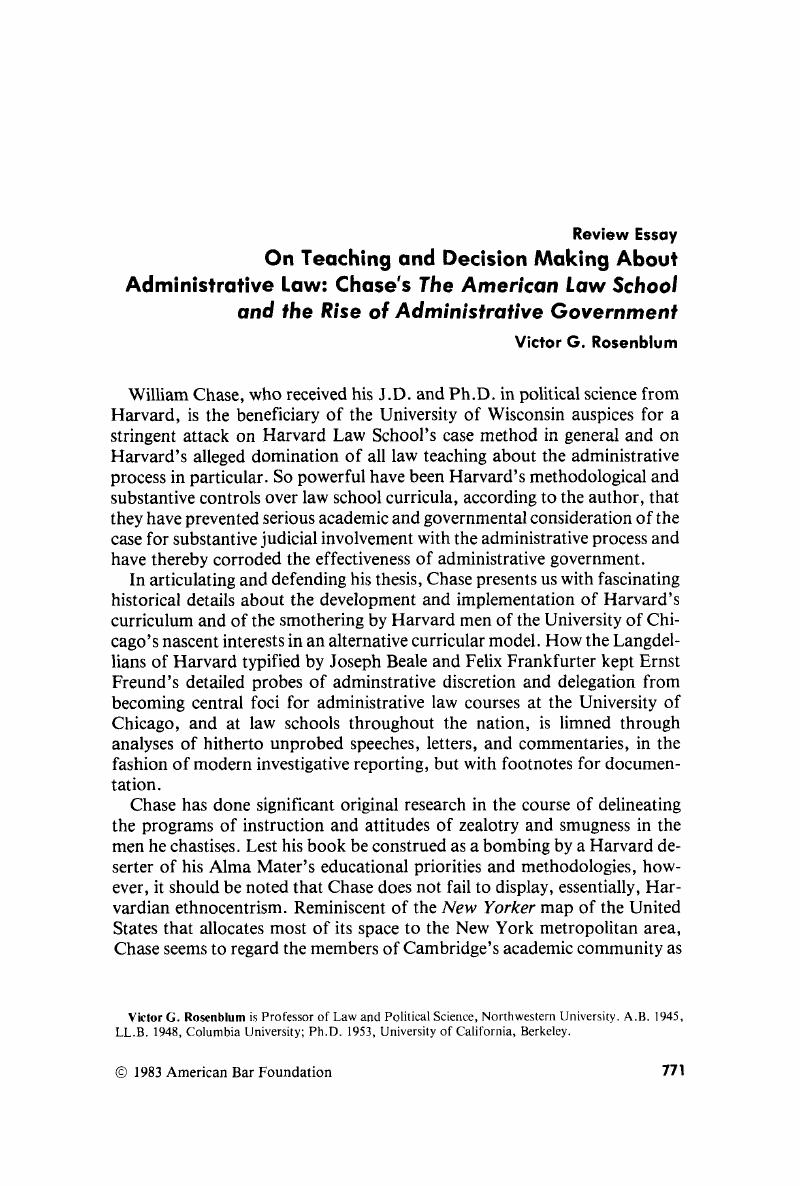No CrossRef data available.
Article contents
On Teaching and Decision Making About Administrative Law: Chase's The American Law School and the Rise of Administrative Government
Published online by Cambridge University Press: 20 November 2018
Abstract

- Type
- Review Essay
- Information
- Copyright
- Copyright © American Bar Foundation, 1983
References
1 Gellhorn, Walter, Stone on Administrative Law, 46 Colum. L. Rev. 734 (1946).Google Scholar
2 Kenneth Culp Davis, Administrative Law Treatise (4 vols. St. Paul, Minn.: West Publishing Co., 1958; id. (2d ed. San Diego, Cal.: K. C. Davis Publishing Co., University of San Diego, 1978-83), 4 volumes published to date of 5 scheduled, plus 1982 supplement. See also his Discretionary Justice: A Preliminary Inquiry (Baton Rouge: Louisiana State University Press, 1969). I had the opportunity to comment on Davis' pioneering works in two articles: Realities of Regulation, 20 Pub. Ad. Rev. 219 (1960), and On Davis on Confining, Structuring, and Checking Administrative Discretion, 37 Law & Contemp. Prob. 49 (1972).Google Scholar
3 William C. Chase, The American Law School and the Rise of Administrative Government (Madison: University of Wisconsin Press, 1982).Google Scholar
4 Frances Kahn Zemans & Victor G. Rosenblum, The Making of a Public Profession (Chicago: American Bar Foundation, 1981).Google Scholar
5 Id. at 52–55. Providing some grist for Chase's critical mill might be administrative law's absence from lists of “helpfu1” courses. Respondents to our questionnaire listed among law school courses found particularly helpful to careers those in contracts, property, torts, evidence, civil procedure, constitutional law, corporations, taxation, and trusts and estates. Contracts headed the list with 50.3% of respondents rating the course as particularly helpful to their careers. On the other hand, respondents did not call for the elimination or shortening of the administrative law course. Only future interests, common law pleading, and property generated significant responses to our question about eliminating or shortening sectors of the curriculum. Id. at 144–50.Google Scholar
6 Victor G. Rosenblum, Law as a Political Instrument (New York: Random House, 1955).Google Scholar
7 Teubner, Gunther, Substantive and Reflexive Elements in Modem Law, 17 Law & Soc'y. Rev. 239 (1983).CrossRefGoogle Scholar
8 Id. at 275.Google Scholar
9 Id. Google Scholar
10 Id. at 280.Google Scholar
11 Consonant with the practice of the U.S. Court of Appeals for the D.C. Circuit, I describe as Vermont Yankee I that court's initial decision invalidating the NRC's licensing practices, National Resources Defense Council v. NRC. 547 F.2d 633 (1976). Vermont Yankee II refers to the Supreme Court's decision reversing and remanding the 1976 court of appeals ruling, Vermont Yankee Nuclear Power Corp. v. NRDC, 435 U.S. 519 (1978). Vermont Yankee III refers to the court of appeals decision in 1982 on remand, NRDC v. NRC, 685 F.2d 459 (1982); and Vermont Yankee IV labels the Supreme Court's 1983 ruling on the appeal from Vermont Yankee III, Baltimore Gas & Elec. Co. v. NRDC, 51 U.S.L.W. 4678 (U.S. 1983).Google Scholar
12 U.S. Nuclear Regulatory Comm'n v. People Against Nuclear Energy, 51 U.S.L.W. 4371 (U.S. 1983).Google Scholar
13 Pacific Gas & Elec. Co. v. State Energy Resources Conservation & Dev. Comm'n, 51 U.S.L.W. 4449 (U.S. 1983).Google Scholar
14 435 US. 519, at 524.Google Scholar
15 Id. at 525.Google Scholar
16 547 F.2d at 653.Google Scholar
17 Id. at 644, 645.Google Scholar
18 435 U.S. 519, at 552–53.Google Scholar
19 Id. at 557–58.Google Scholar
20 685 F.2d 459, at 545.Google Scholar
21 Id. at 467.Google Scholar
22 Id. Google Scholar
23 Id. at 496-91.Google Scholar
24 Id. at 517.Google Scholar
25 Id. at 518.Google Scholar
26 Id. Google Scholar
27 51 U.S.L.W. 4678, at 4680.Google Scholar
28 Id. at 4681, 4682.Google Scholar
29 678 F.2d 222 (1982).Google Scholar
30 51 U.S.L.W. 4371, at 4373.Google Scholar
31 Id. at 4374.Google Scholar
32 Id. Google Scholar
33 That judges are “babes-in-the-woods” or even “relative babes-in-the-woods when it comes to understanding the public policy implications of their offices” is disputable. Justice Frankfurter was certainly a model of concern about public policy implications of judges' work. His “Dialogue” with my distinguished colleague Nathaniel Nathanson, for example, remains to this day one of the most sophisticated commentaries on judicial review's potential for “mischievous abstraction.”Frankfurter, Felix & Nathanson, Nathaniel L., Forbidden Dialogue: Standards of Judicial Review of Administrative Action, 1963 Sup. Ct. Rev. 2060.Google Scholar
34 51 U.S.L.W. 4449, at 4450.Google Scholar
35 Id. at 4453.Google Scholar
36 Id. at 4453, 4456.Google Scholar
37 51 U.S.L.W. 4371, at 4374.Google Scholar
38 Lettie M. Wenner, The Environmental Decade in Court 176 (Bloomington: Indiana University Press, 1982).Google Scholar
39 A glance at the table of contents of the Fall 1982 and Winter 1983 Administrative Law Review yields typical illustrations of my point. I cite these articles for a fortiori purposes. If the organized bar's own publication revels in empirical and theoretical studies, the more traditional academic law reviews must do so even more. I would call attention and approbation to the Aranson, Peter H., Gellhorn, Ernest, & Robinson, Glen O. article A Theory of Legislative Delegation, 68 Cornell L. Rev. 1 (1982).Google Scholar
40 Strauss, Peter L., Teaching Administrative Law: The Wonder of the Unknown, 33 J. Legal Ed. 1 (1983).Google Scholar
41 Id. Google Scholar
42 Schuck, Peter H., Organization Theory and the Teaching of Administrative Law, 33 J. Legal Ed. 13 (1983).Google Scholar
43 Mashaw, Jerry L., Mirrored Ambivalence: A Sometimes Curmudgeonly Comment on the Relation ship Between Organization Theory and Administrative Law, 33 J. Legal Ed. 24, 26, 29 (1983).Google Scholar
44 These and other draft reports, prepared for the most part by administrative law professors, are available from the Administrative Conference of the United States, 2120 L Street, N.W., Washington, D.C. 20037. The conference, composed of agency representatives, private practitioners, and members of the academic community, takes appropriate pride in its mission “to make the government's administrative system both more fair and more efficient, and thus more responsive to the policy mandates of the President and Congress.”Google Scholar


